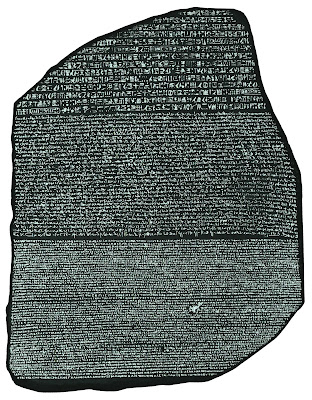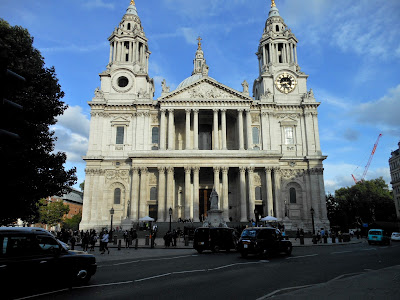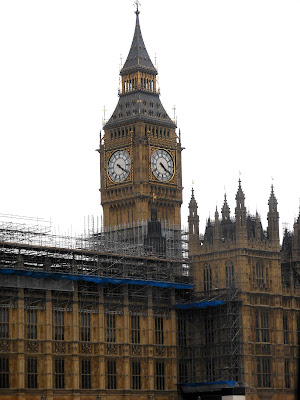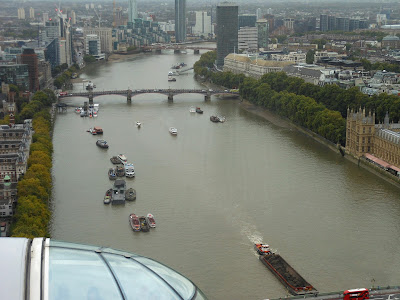Day 18 London Friday, Sept 28, 2017
Buckingham Palace, just before the changing of the guards. THOUSANDS of people were crowded in to watch it. Oh my! On this all-day tour, we also visited St. Paul's Cathedral, The Tower, Thames River cruise, and the London Eye.
We had to subway it to the Victoria train station, and then walk a few blocks to the bus station by 8:15 am to begin our tour. When we departed, we scurried across town to St. Paul's, passing many of the sights we had seen the afternoon before on our walking tour. We got to the cathedral a bit early, and it was raining, so we had to hang out a bit before we got in. This is the photo of St. Paul's I'd taken the day before, when it was sunny. On both visits, Janet and I wanted to buy bird feed for tuppence from the old bird lady, but she was not there. We sang the song anyway.

This is the Queen Anne statue in front of St. Paul's, and notice the statue at the lower left; that's an American Indian! The four "attendant ladies" sub-statues are Britannia, Ireland, the American Colonies, and France. So, England's American Colonies were appropriately represented by a Native American! How about that?
Of course, the architect was Sir Christopher Wren. It's the world's 2nd largest cathedral (to St. Peter's in Rome), and the dome is 365 feet tall. It has dominated London's skyline for over 300 yrs. It is a working church with hourly prayer and daily services.
The church before the present one (the 4th St Paul's, referred to as
Old St Paul's), was also huge. It was begun by the Normans after the 1087 fire, and was added to many times over the years until it was a major cathedral. It burned down in 1666.
Our guide explained how St. Paul's survived the Blitz, although struck by bombs twice. They now know that the German bombers deliberately avoided it because it helped them visually navigate since it was so tall and recognizable from a distance.
Funerals held there include the Duke of Wellington (who has the largest monument inside), Lord Nelson, Winston Churchill, Margaret Thatcher, and George Mallory (Mt. Everest fame). Christopher Wren's grave is there too, but quite small. Charles and Diana were married there. The peace services marking the end of the First and Second World Wars occurred there.
It was, of course, magnificent to see inside. No photos allowed. We loved getting to hear the boys choir singing for a private service in the crypt chapel.
On our walk back to the bus, we passed this public garden with a church tower. It is Christ Church Greyfriars, established in the 13th century. After the Great Fire, who else but Wren designed the new church, but it was destroyed during the Blitz, except for what you see here. They left it as was and made it a garden.
Our bus then scurried back across town to Buckingham Palace. It was amazing how many people were there to watch the changing of the guard. Our guide had us observe the marching band and guards as they were marching toward the palace, because that way we could get front-row "seats". Thus, we did not watch the actual changing taking place in front of the palace. By the way, that's Queen Victoria on her throne on the monument.
Here's a close-up of how jammed the sidewalks were. The street is open because that's where the guards would be marching, to the gate on the far right of this photo.
Our guide took us to where the guard band was "warming up" but playing songs for the fans. It truly reminded me of Brian's UCLA marching band playing songs at the tailgate parties. This was quite a distance from the palace, but at least here we could have unobstructed views of the upcoming pomp and circumstance.
A few yards away was where the guards were getting ready to march to the palace.
And here they come! I next took a great video, but we can't put it here.
There go the guards. From here, they had to march about 500 meters to get inside the palace gates.
Off they went. At this point, we still had some time, so Janet and I decided to see if there was any way we could glimpse the actual guard changing up with the throngs of tourists.
We could not get close enough to the rails to see a darned thing. My picture above was from holding my camera as high as I could and just snapping. I never knew what what the guard changing looked like until I saw this photo.
Here's why we couldn't see anything. That guy in the blue jacket also was holding his camera high for a photo, but he was doing it two-handed; I had room only to raise one arm.
Before our bus departed, I enjoyed this view through St. James Park, which is between Buckingham Palace and the gov't buildings near 10 Downing Street.
Our bus then scurried back across London
again, to reach the Tower of London.
I took this out the bus window as we were crossing Tower Bridge. Our bus had crossed South London, below the Thames, so that we could cross the bridge.
Again, out the bus window, I got this shot of where the bridge meets halfway. Tower Bridge is a draw bridge, but rarely has to stop traffic and raise up for boats. But it does! It was built 1886 to 1894. Pedestrians can climb to the permanent crossing high up, meant for when the bridge is open, but most do it just for fun.
When we departed the bus at the Tower, we were given an hour free for lunch. Janet and I bought fish and chips from a vendor and ate outside where the birds were begging tourists to share. We had time, so we crossed the boulevard and had a pint at the Trinity House pub.
Eventually it was time to tour the Tower. Our guide showed us things inside for about 30 minutes, and then we were on our own for another hour or so. It is officially Her Majesty's Royal Palace and Fortress of the Tower of London. It was founded towards the end of 1066 once Wm the Conqueror became king.
The White Tower, which gives the entire castle its name, was built by The Conqueror
in 1078 and was a resented symbol of oppression, inflicted upon London
by the new ruling elite. The castle was used as a prison from 1100 until 1952, although that was not its primary purpose. A grand palace early in its
history, it served as a royal residence.
I took this photo of a rendering of what the Tower looked like a few centuries ago when the moat was still being used and boats still delivered prisoners at Traitors' Gate at the front. As a whole, the Tower is a
complex of several buildings set within two concentric rings of
defensive walls. It houses the Crown Jewels, which Janet and I saw. There still are apartments used by the guards and Yeoman Warders.
We are about to walk under Bloody Tower, which was a torture chamber for much of its history.
Here is an ancient Roman wall, but it's not part of the original Roman city wall, which I thought it was until I asked someone.
Our tour guide explained how this was where Anne Boleyn lost her head. King Henry made out as if he was sorry for her, and wanted to make things as "comfortable" for her as he could as the deed was done. So, he had made a cushion for her to rest her chin on. That building behind is where they keep the Crown Jewels.
In front of the Crown Jewels building is a guard, and they go through a formal changing-of-the-guard ceremony there every so often. They did it just as we approached, so I took a video of it. Once inside, it was a definitive "regal" presentation of the jewels. Janet and I walked pretty fast through it; they would have meant more, we figured, to a subject of the Crown. It was interesting that even though they are on official display, they are still used and worn at times. They just remove it from its case, and then return it when the wearer is done with it.
This was quite a decorated cannon! The sign said it was originally from 1607, but brought to England from Malta in 1820. The Duke of Wellington then ordered that it be all decorated up, and that all was done in 1827. You can see the heralds and vines, and that is an engraving of St. Michael overthrowing satan near its front.
These tracks, and the ruin in the foreground, actually ARE where the original Roman City Wall was. So they built the Tower around where the city wall was - pretty funny.
This is Traitors' Gate, where you would arrive (by small boat) if you were heading into the prison.
Janet and I toured Beauchamp Tower, which was the main prison tower. You could see that many had inscribed their names or messages on the walls. We then toured Wakefield Tower, which is now a torture museum. In the 1500s and 1600s, during a period of extreme political and
religious upheaval, torture was used here. They know of 48
prisoners who were physically tortured and interrogated to give up the
names of their conspirators.
The photo above shows the rack, and we all know how that works. My photo of the "scavenger's daughter" did not come out, but it uses the opposite method - it compressed or contorted the victims instead of stretching them. The replica we saw held the body tight
in a kneeling-down position which would become incredibly painful very
quickly, and lead to the lungs filling with blood.
We also watched a little film about the notorious murders of the princes in 1483. The incident is one of
the most infamous events associated with the Tower of London. Shakespeare also made this famous in his play about the wicked uncle, King Richard III. Shortly after the death of Edward IV, his son became king but he was only 12, so he needed a guardian. His uncle, the Duke of Gloucester, was declared his Lord Protector.
Protector my foot! The evil uncle confined Edward and his 9-yr-old brother to the Tower and they were never seen again. The Duke of Gloucester proclaimed himself King Richard III. Everyone "knows" the uncle had them murdered! They even found what they believe were their bones in 1674, when they were renovating in the White Tower.
When we were done at the Tower, and had some coffee to warm up out of the rain, we walked to our river boat for our cruise.
I took this photo as we were embarking on our boat. You can see the Tower on the left, and pedestrians, and the low river level at this moment.
The writing on the wall there says "Entry to the Traitors' Gate." It's now walled over, but that had been a scary spot!
I will post many photos I took during our cruise. We first went a little ways east, and then we turned around and went upriver several miles until we reached the old Battersea Power Station, and then turned around again and finished at the London Eye.
It was raining as we cruised under the Tower Bridge headed east.
A fancy sailing ship at St. Katherine's Dock.
I just
had to take that photo!
The Dixie Queen paddleboat.
HMS Belfast, a cruiser active during WWII and the D-Day landings.
Behind that river wall is a replica of Sir Francis Drake's Golden Hind. I wish we'd been able to see it up close.
The Millennium Bridge, for pedestrians only. Directly north (the other direction from this photo) is St. Paul's Cathedral.
Blackfriars Bridge.
This shows the London Eye, and Parliament and Big Ben in the back, and the Golden Jubilee Bridge. If you go right on the bridge, it leads right up to Trafalgar Square and where we were staying.
The old County Hall, now housing many shops, museums, and attractions.
A "floating" restaurant.
The Vauxhall Bridge, with fancy new apartments (condos?) along the shore.
Look at that modern architecture!
Parliament on the return down river.
Look at the intricate designs on this Parliament tower.
Big Ben, which wasn't chiming at this time because it was undergoing restoration work.
The river cruise ended at the Eye, but we had tickets via the tour that allowed us to bypass the line and we went right to the front to board this capsule.
In this photo, we had just gotten going.
There were only about 10 people in the large capsule, so we had plenty of room to move around and take photos in any direction at any time. That's the Charing Cross Underground station in the background.
You can see St. Paul's off in the distance on the far right.
We were at the apex when I took this photo.
That's Westminster Cathedral, which we would be seeing the next day. You also can see on Big Ben that it's 4:46.
Looking upriver. Lots of boats.
The Royal Air Force Memorial directly across from the Eye.
After we departed the Eye, we asked where there was a nearby pub. We were directed to this one. It was modern, rather than having the traditional look, but the beer was just as good. We had to laugh at this name.
We originally thought we would take a bus back to our flat, but when we couldn't find the bus, we decided to walk. Janet's foot was doing okay. So, we walked along the river until we passed under the Golden Jubilee Bridge, and then decided to cross it.
On the way to ascend the bridge, we passed the Nelson Mandela bust, honoring his life.
This passenger bridge was built adjacent to the existing old Hungerford rail bridge.
Once on the north side of the river, we walked east along it and through the Victoria Embankment Gardens. We passed by this Cleopatra's Needle monument that the tour guide on the cruise boat had pointed out. It's an actual ancient obelisk brought from Egypt (although it has nothing to do with Cleopatra). But what our guide had laughingly told us was that the workers erecting the lion statues on either side made them to face the wrong direction!
Those two lions are supposed to be protecting the obelisk from "attackers", but instead, they will never see the attackers approaching!
Janet and I used our subway map as best we could to walk north and find our way back to our flat. We eventually made it. After resting, we went out to find dinner, and settled on a small Thai restaurant because every pub was bursting at the seams, with patrons spilling WAY out on the sidewalks. The Thai food and service were excellent!
After dinner we strolled through Leicester Square and Piccadilly Circus, and WOW, were we amazed at how "happening" it all was. The "Times Square" of London. And to think our Airbnb flat was only a couple hundred meters from it.
Neon lights everywhere, street performers, big restaurants (and a Burger King!), casinos, the Odeon Cinema, bars and clubs.
This was Swiss Court, right in the middle of Leicester Square, with all the Swiss canton emblems. The plaque in the middle notes that this was erected in 1991 on the 700th anniversary of the Swiss Confederation. Above the Swiss flag in the center is engraved "1291-1991".
Piccadilly Circus was just as flashy, but I didn't take any pictures. On the walk back we happened to be in China Town.
Janet and I thought this cat was cool on a wall in their China Town. Maybe it was an omen that we would soon be the proud owners of a pet cat with this same coloring. Bad cat!
We were tired and went back to rest for a little while before turning in. We were going to have another big day on Saturday, and I also needed to upload and edit all my photos from the day.






































































































